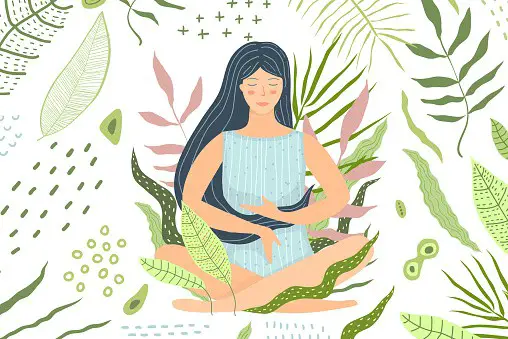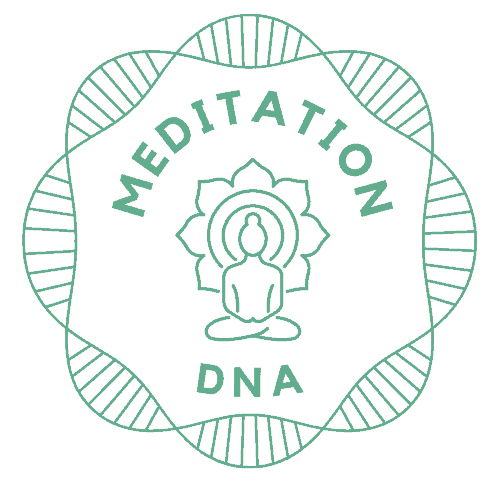
It is easy to draw comparisons between the blissful, effortless daily processes of nature and meditation. They not only offer similar feelings of groundedness, tranquility, and peace but being in nature and meditating also have similar effects on our brain chemistry.
Let’s first talk about…
What is a meditative state?
A meditative state is a mental state characterized by inner peace, clarity of mind, deep concentration, and blissful joy. Meditating helps us become more aware of our thoughts, feelings, and emotions, which allows us to gain insight into how we behave in certain situations, and also allows us to calm down when things start getting stressful.
Being in a meditative state is different from meditating. Meditating is a specific action that is done to reach this state of awareness whereas there are also many other actions that bring on a meditative state naturally as a ‘by product’ of the action. For example, washing dishes can access a meditative state but it is not necessarily meditating.
Meditation with nature
Do you ever wonder why meditation retreats and monasteries of all spiritual traditions tend to be located in mountainous regions or forests? Meditation has been practiced for thousands of years by people from different cultures and traditions across the world. It’s an ancient practice that helps us understand ourselves – nature has a natural (excuse the pun) ability to bring wisdom and perception to the forefront of our minds.
Outdoor meditation, therefore, helps us become more aware of our surroundings by activating our sensory systems.
In addition, the usual distractions or worries of everyday life seem farther away and somewhat less important. Most people who practice meditation report finding it easier to let go of their worries and their electronic devices when they’re out in nature instead of sitting alone at home.
In Asia, the accomplished meditators of old believed that solitude in the wilderness was conducive to advanced meditation practice.
They would withdraw from society to live in secluded mountain monasteries or hide out in remote jungles where they could pursue their spiritual practice without interference. Ancient poems and chants often invoke the beauty of such places. A verse by Han-shan , a 7th century hermit who lived on Cold Mountain in China, describes this experience beautifully:
Today I sat before the cliff, Sat a long time till mists had cleared.
A single thread, the clear stream runs cold;
A thousand yards the green peaks lift their heads.
White clouds the morning light is still;
Moonrise the lamp of night drifts upward;
Body free from dust and stain, What cares could trouble my mind?
An emerald stream—pure spring water,
Cold Mountain’s moonlight is luminous.
In silence I realize my spirit is clear.
Seeing the empty sky, things grow even more still.(From Cold Mountain: 100 Poems by the Tang Poet Han-shan, translated by Burton Watson, Columbia University Press)
Accessing A Meditative state through nature
Nature is the ultimate healer.
It’s no wonder that so many of us seek out its healing powers and embrace them as part of our daily lives. We know that spending time in natural settings can be restorative, but we often don’t realize just how much nature has to offer us.
In fact, there are numerous health benefits associated with being outside in nature, including stress relief, improved mood, increased focus, and even better sleep.
Nature meditation or meditation in nature, as a mindfulness practice, can therefore take this sense of awareness and stress relief to the next level.
The experience of nature brings our bodies back to their most natural state – remember there was a time before technology, before social media, and before buildings even. There was a time when the human race was one with nature as hunter-gatherers.
When was the last time you walked barefoot outside?
How often do you walk outside and feel the soil of the earth underneath the soles of your feet and in between your toes?
The answer is probably not that often anymore – and the last time was probably when you were a child or a young adult.
And while there are many reasons why we don’t get out and play as much as we should these days, one of them is that our bodies aren’t getting enough exposure to the outdoors or exercise.
Exposure to nature as well as the experience of nature is fundamental to our health and wellbeing. The sun provides us with sufficient Vitamin D needed for immunity and healthy bones while the trees and fresh air provide our lungs with a clean source of oxygen needed to keep our brains alert for increased cognitive performance as well as keep our muscles functioning optimally – not to mention that this is the vital element that keeps us alive.
Our sedentary lifestyles have left us with an epidemic of obesity, diabetes, heart disease, cancer, depression, anxiety, and other chronic health conditions.
Apart from it feeling great and well, perhaps even a little bit ticklish, walking barefoot outside may be doing you some good too. Research has shown that walking barefoot in the grass can lower stress levels by up to 62%.
Why would this be the case?
Feeling the ground beneath us in direct contact with our skin provides us with a sense of support, stability, and knowing that we are connected to that which gives life. We can directly tap into the energy of nature.
Similarly, ever wondered why when some people feel overwhelmed or emotionally overstimulated they lie on the floor?
This isn’t just for dramatic effect in the movies – it literally brings us to a calmer state as our bodies feel ‘held’ and ‘grounded’ or ‘rooted’ and therefore our minds tend to follow. Anybody who has had a cry on the floor can tell you how cathartic this is and just how much better it makes one feel.
Beyond simply helping us stay healthy physically, nature has an impact on our minds too. Much like meditation, spending time in nature is also linked to a greater sense of happiness.
It is not likely to find someone who does not find being somewhere in nature like, walking on a beach or a forest, playing in a park, or even just sitting in their own garden blissful.
The oldest ‘treatment’ for a cluttered and overwhelmed mind is to “take a walk outside to clear your head.”
The thing is… even when we know the benefits of nature and the positive effect it has on our physical bodies and psyche many people still don’t make the effort to actually get outside for a deep breath of fresh air and some sunshine on their skin.
Most people always feel that they do not have time to get outside, take a break or even book a weekend away camping.
Clearly, a social mind shift is necessary.
When we take this well-deserved break and time for ourselves to strip ourselves from distractions and come back to the basics, the root of it all, we discover a lot of insights. It can act as almost a reset of the mind and body by disengaging our stress and fight or flight response which is controlled by our sympathetic nervous system.
All of this can be accessed by just simply opening a door and taking a step outside.
Make the time to get back to what’s important: you. Take a well-deserved mental health day or vacation guilt-free and take in the good vibes from nature. For those who find it difficult to sit still and meditate quietly on a cushion, spending time outside may be just the answer to reaching a new level of consciousness, a nature-induced meditative state.
Nature and mindfulness
Disconnecting from distraction and tapping into focus
Being present in nature demands our attention and our focus. It helps us focus on one thing at a time by forcing us to simplify our thinking. We’re focused on what’s right here and now. We get absorbed into our surroundings and tap into being present.
Instead of being distracted by notifications, social media, technology, or work, we tune into ourselves; listening for the quiet moments. We’re not distracted by others’ needs either.
In turn, we become tuned into our lives in real-time and gain an enhanced level of self-awareness. You start to notice the simple things when they happen—the sun shining, the wind blowing, the sounds, and the scents.
In an article for Travel and Leisure , Sharon Salzberg, a Buddhist meditation teacher, speaks to the importance of quieting the mind and disconnecting from distractions. She notes that when we do, “We can develop or deepen our capacity to find stillness of mind and greater awareness. These are skills that, if we keep practicing them, can affect every aspect of our lives.” At the core of a meditation practice is finding internal focus while the outside word continues to spin around us. Removing yourself from distractions (or setting them aside ) is a helpful step in the meditative process, and in life. (wanderlust.com)
The Creation of our creative minds through nature
The great thing about being in nature is that it allows us to connect with ourselves, our surroundings, and each other. The more connected we are, the better able we are to cultivate creativity.
In a study published in the journal Frontiers in Human Neuroscience, researchers found that people who took part in outdoor activities were more creative than those who didn’t. They noted that this was true regardless of age, gender, education, income, or occupation. Spending time in nature helps us tap into our creative beings.
Creativity is inspired by nature.
Feeling a bit stuck, plagued by writers’ block, or simply lacking inspiration?
It might be time for some restorative downtime. Our brains often operate either at full speed or at low speed, stuck somewhere between periods of mental clutter and mundane routines.
Head out into nature! Change your perspective and shift your mindset. Just like meditation helps clear out clutter from our minds, so too can time spent in nature help clear away stress and anxiety. It’s no wonder why so many works of art and literature reference and draw inspiration from nature.
It’s a place to go to help quiet the mind and create space for new and innovative ideas.
Some of the greatest writers and poets like Ralph Waldo Emerson and Henry David Thoreau sought refuge and inspiration within nature, spending copious amounts of time in the woods.
Thoreau, who has been said to have embraced the practice of meditation , wrote about his motivation to spend time immersed in nature in the woods.
“I went to the woods because I wished to live deliberately, to front only the essential facts of life, and see if I could not learn what it had to teach.” Getting in your outdoor time doesn’t mean you have to take a week off of work or camp alone in the woods for a month. Find what best suits your schedule and personality. Discover what inspires you the most to get outside. (wanderlust.com)
Much like meditation, nature is refreshing, enlightening, and uplifting for our minds and spirit.
When we combine the two that is where the real magic can happen!
Try this simple nature meditation:
Take a walk on the grass barefoot and find a quiet, tranquil place outside, this can be in any natural setting
Leave distractions and technology behind
Sit or lie down on the earth/soil/sand/ground
Close your eyes
Feel your body rooted in the ground beneath you
Now start to notice your surroundings
What sounds do you hear? Be specific
What can you smell?
Maybe even open your eyes – what can you see?
What sensations can be felt on the skin?
Take in all the beauty around you.
In short, get out there and experience the outdoors because this might just be the easiest and most accessible way to practice mindfulness or a deeper state of awareness!
Get your hands and feet in the soil through gardening.
Get out there! Go hiking, biking, boating, swimming, fishing, climbing, running, etc., whatever floats your boat. You don’t need to follow any specific path when you want to benefit from and enjoy nature.



